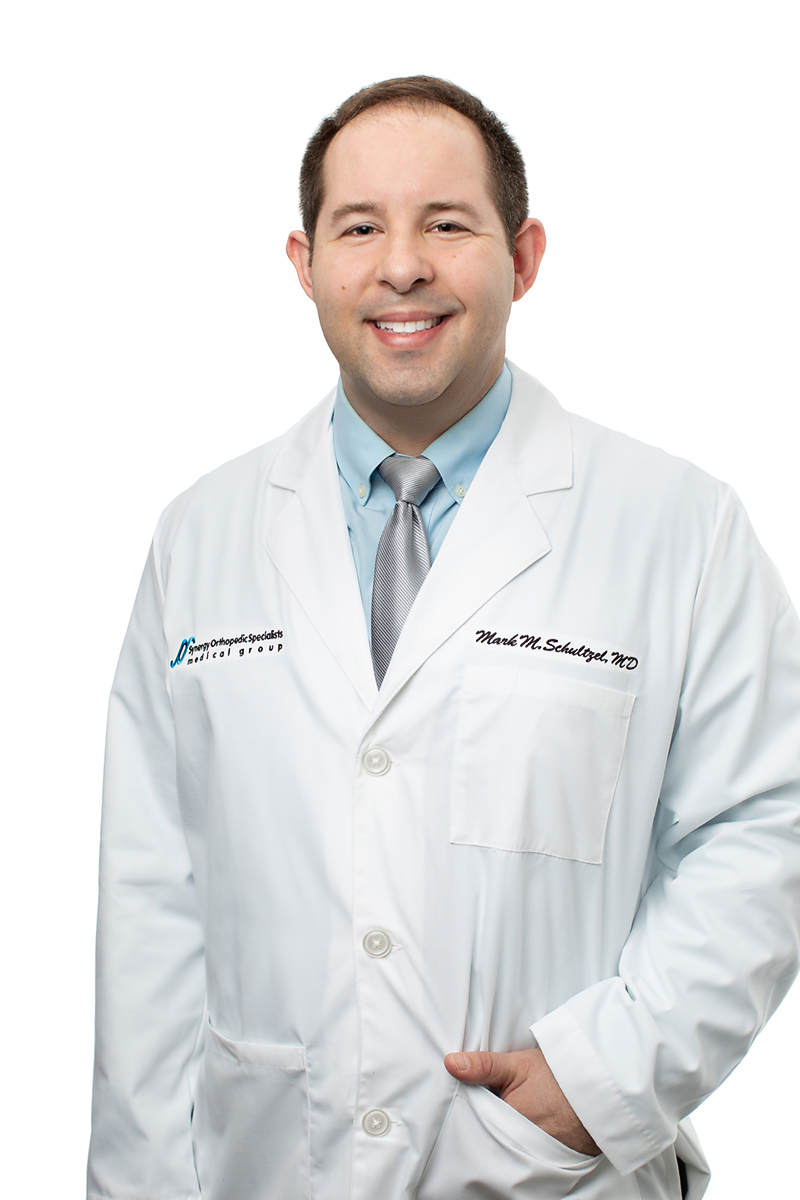Mark Schultzel, MD
 Shoulder pain is incredibly common. In fact, it’s the third most common musculoskeletal complaint — meaning pain that affects the bones, muscles, ligaments, tendons and nerves.
Shoulder pain is incredibly common. In fact, it’s the third most common musculoskeletal complaint — meaning pain that affects the bones, muscles, ligaments, tendons and nerves.
Shoulder pain also falls into a higher intensity bracket because the shoulder requires many muscles to function — and injury to even one can cause significant pain.
“Pain in the shoulder doesn’t discriminate,” says Dr. Mark Schultzel, an orthopedic surgeon from Synergy Orthopedic Specialists. “Whether it’s caused by arthritis or an injury, it can happen to anyone at any time. The biggest issue with shoulder pain is that those suffering don’t always address it. Instead of fixing the issue, they exacerbate it by trying to live with it.”
The most common causes of shoulder pain include:
- Rotator cuff injuries: Damage to the group of muscles and tendons that surround the shoulder joint, which keeps the upper arm bone (humerus) within the shallow socket of the shoulder.
- Labral tears: Damage to the cartilage tissue attached to the rim of the shoulder socket that keeps the ball of the shoulder joint in place.
- Arthritis: The wearing down of cartilage on the ball or socket sides of the shoulder joint.
- Subacromial bursitis: Inflammation of bursae — the thin cushions between the bones and moving parts of the shoulder.
- Fractures: Trauma or injury to at least one of the three bones in the shoulder: the scapula (shoulder blade), clavicle (collarbone) or humerus (upper arm bone).
- Frozen shoulder: Inflammation of the tissue surrounding the shoulder joint, which causes the shoulder to become stuck and limited in movement.
Treating shoulder pain at home
When facing shoulder pain, many choose home remedies over consulting with their doctor. However, because shoulder pain has so many different causes, it’s important to discuss symptoms or injuries to make sure the treatment is right.
“I think a lot of people worry that the only solution to their pain is surgery,” say Dr. Schultzel. “Yet, there are so many options for patients with shoulder pain. Patients often forget about the RIICE method, which is rest, ice, ibuprofen, compression and elevation.”
Another common treatment for shoulder pain is the use of a steroid, or cortisone, shot. These injections offer easy and safe relief for inflammation for many people — and can be administered quickly and conveniently in a doctor’s office.
Long-lasting relief from injections may vary. “Obviously, it depends on what your diagnosis is,” says Dr. Schultzel. “Steroid injections can be a very effective solution. Yet in some cases, such as arthritis, the medication wears off — and the worse the arthritis becomes, the less effective the injections will be in the long run.”
Surgery for shoulder pain
When shoulder pain becomes difficult to manage, and it begins to interfere with a person’s quality of life, an orthopedic surgeon can help diagnose and treat the issue. In general, the orthopedic surgeon will consider three things in their initial evaluation: the patient’s narrative, a physical exam and imaging.
An orthopedic surgeon can outline a treatment plan based on the diagnosis, which in many cases could be as simple and noninvasive as physical therapy, steroid injections, PRP (platelet-rich plasma), chiropractic care and acupuncture.
For bigger issues, such as rotator cuff and labral injuries, arthroscopic surgery has become the gold standard — revolutionizing shoulder surgery through minimally invasive techniques that allow patients to get back to their lives.
“Arthroscopic surgery can mean a world of difference to a patient,” says Dr. Schultzel. “Injuries should be attended to quickly, as good long-term results are shown in patients who don’t delay.”
Another surgical solution is shoulder replacement, which offers relief to patients with arthritis who have found little success with non-operative solutions. “Shoulder surgery is not for everyone,” says Dr. Schultzel. “However, for those patients who are finding pain, weakness or stiffness unbearable, a shoulder replacement can be a game-changer.
Whatever the diagnosis, Dr. Schultzel’s main message is not to live with the pain. In many cases, fear of next steps overshadows the pain itself — and people can suffer for months, years and even decades.
“Whether I recommend that a patient undergo physical therapy or surgery, there is nothing more rewarding than helping someone regain a sense of independence when their shoulder is no longer painful or limiting,” says Dr. Schultzel. “I chose this profession for a reason, and that was to help people return to the activities that they love.”



